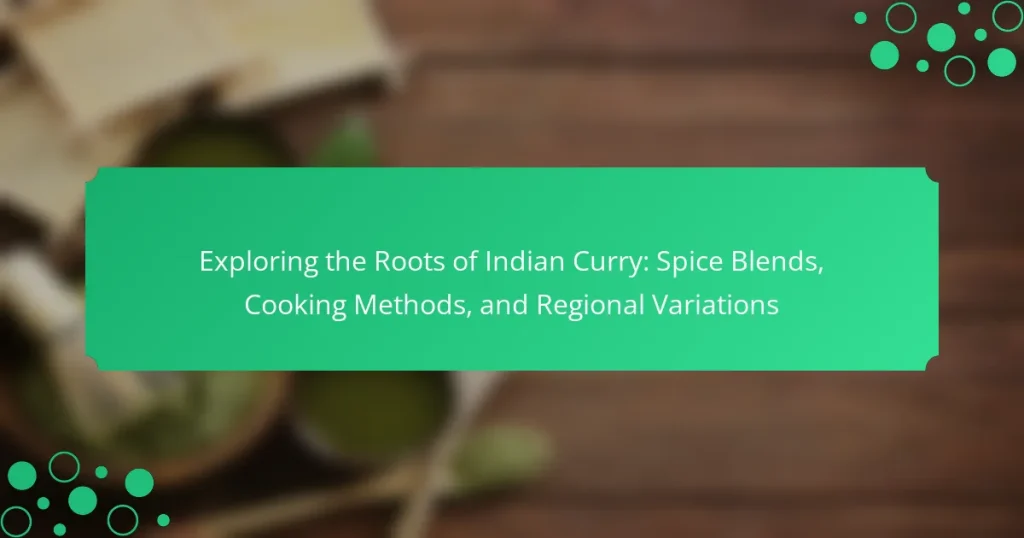Indian curry, a culinary tradition from the Indian subcontinent, has evolved over centuries through a blend of regional spices and cooking methods. The article explores the historical roots of Indian curry, tracing its origins back to the Indus Valley Civilization and the influence of texts like Ayurveda. Key spice blends such as Garam Masala, Curry Powder, and Tandoori Masala are highlighted for their role in enhancing flavors and aromas. Various cooking techniques, including sautéing, simmering, and steaming, are discussed, along with popular regional variations like North Indian, South Indian, East Indian, and West Indian curries, each characterized by unique ingredients and preparation methods.

What are the origins of Indian curry?
Indian curry originates from ancient culinary traditions in the Indian subcontinent. It evolved from a blend of spices and cooking methods used in regional cuisines. The use of spices dates back to the Indus Valley Civilization, around 2500 BCE. Historical texts like the Ayurveda mention various spices and their medicinal uses. The word “curry” itself derives from the Tamil word “kari,” meaning sauce. British colonial influence in the 18th century popularized the term globally. Today, Indian curry encompasses a wide variety of regional styles and flavors. Each region contributes unique ingredients and preparation techniques.
How did historical influences shape Indian curry?
Historical influences significantly shaped Indian curry through the integration of diverse spices and cooking techniques. The ancient trade routes facilitated the exchange of spices like black pepper and cardamom from South India. Persian and Mughal invasions introduced rich gravies and cooking methods. British colonialism led to the adaptation of curry for Western tastes, resulting in dishes like Anglo-Indian curry. Regional variations emerged due to local ingredients and cultural practices. Each historical period contributed unique attributes to curry’s evolution. The blend of influences created the rich tapestry of flavors found in Indian curry today.
What role did trade routes play in the development of curry?
Trade routes significantly contributed to the development of curry. They facilitated the exchange of spices and ingredients essential for curry preparation. Spices like turmeric, cumin, and coriander traveled along these routes from regions such as India, Southeast Asia, and the Middle East. This exchange led to the blending of culinary traditions and flavors. Historical trade networks, such as the Silk Road and maritime routes, connected diverse cultures. These interactions influenced local cooking practices and spice usage. As a result, curry evolved into various regional forms across different cultures. The incorporation of foreign spices enriched the flavor profiles of curry dishes.
How did cultural exchanges influence curry recipes?
Cultural exchanges significantly influenced curry recipes by introducing diverse ingredients and cooking techniques. Historical trade routes facilitated the exchange of spices between India and various cultures. For instance, the introduction of chili peppers from the Americas transformed traditional Indian curries. Additionally, British colonial influence led to the creation of dishes like chicken tikka masala, which combined Indian and British culinary elements. The migration of Indian communities worldwide also resulted in adaptations of curry recipes to suit local tastes. These interactions enriched the flavor profiles and preparation methods of curries across different regions.
Why is curry considered a staple in Indian cuisine?
Curry is considered a staple in Indian cuisine due to its versatility and rich flavor profile. It incorporates a variety of spices, which are fundamental to Indian cooking. These spices not only enhance taste but also provide health benefits. Regions across India have their unique curry recipes, showcasing local ingredients and cooking methods. Historical influences, such as trade routes, have contributed to the diversity of curry. Cultural significance also plays a role, as curries are often part of traditional meals and celebrations. The adaptability of curry allows it to be paired with various dishes, making it a central element of Indian dining.
What nutritional benefits does curry provide?
Curry provides various nutritional benefits, including antioxidants, vitamins, and minerals. The spices used in curry, such as turmeric, contain curcumin, which has anti-inflammatory properties. Additionally, curry often includes ingredients like garlic and ginger, known for their immune-boosting effects. Many curries are rich in fiber, promoting digestive health. They also provide essential vitamins, like vitamin C from tomatoes and vitamin A from leafy greens. The combination of spices can enhance metabolism and support weight management. Overall, curry is a nutrient-dense dish that contributes to a balanced diet.
How does curry reflect regional diversity in India?
Curry reflects regional diversity in India through variations in ingredients, preparation methods, and flavors. Each region has distinct spices that define its curry. For example, North Indian curries often use dairy products like yogurt and cream. In contrast, South Indian curries frequently incorporate coconut and tamarind. The cooking techniques also vary; some regions favor slow cooking, while others prefer quick stir-frying. Additionally, local agricultural practices influence the availability of ingredients. For instance, coastal areas utilize seafood, while inland regions focus on meats and lentils. This diversity showcases India’s rich cultural tapestry and culinary heritage.

What are the key spice blends used in Indian curry?
The key spice blends used in Indian curry include Garam Masala, Curry Powder, and Tandoori Masala. Garam Masala typically consists of spices like cumin, coriander, cardamom, and cloves. Curry Powder is a blend that often includes turmeric, cumin, and fenugreek. Tandoori Masala is known for its inclusion of yogurt, paprika, and various spices for marinating meats. Each blend contributes distinct flavors and aromas to the curry dishes. These spice blends are foundational in Indian cuisine, enhancing the complexity and richness of the food. Their usage varies by region, reflecting local preferences and available ingredients.
What are the most common spice blends found in Indian curry?
The most common spice blends found in Indian curry include garam masala, curry powder, and tandoori masala. Garam masala typically consists of spices like cumin, coriander, cardamom, and cloves. This blend is often added towards the end of cooking to enhance flavor. Curry powder usually contains turmeric, coriander, cumin, and fenugreek. It is a versatile blend used in various curry dishes. Tandoori masala is primarily used for marinating meats and includes spices like paprika, garlic, and ginger. Each of these blends contributes distinct flavors and aromas to Indian curry, reflecting regional variations and culinary traditions.
How do specific spices contribute to the flavor profile of curry?
Specific spices are essential in shaping the flavor profile of curry. Each spice contributes unique tastes and aromas. For example, cumin adds earthy notes. Coriander provides a citrusy undertone. Turmeric imparts a warm, slightly bitter flavor. Fenugreek offers a sweet, nutty taste. Additionally, chili peppers bring heat and depth. Black mustard seeds add a pungent, sharp flavor. These spices work together to create a complex and balanced dish. The combination of these flavors defines the regional variations of curry.
What are the traditional methods of preparing spice blends?
Traditional methods of preparing spice blends include dry roasting, grinding, and mixing. Dry roasting involves heating spices in a pan to enhance their flavors. This method releases essential oils, making the spices more aromatic. Grinding is performed using a mortar and pestle or a spice grinder. This process transforms whole spices into a fine powder, allowing for better integration in dishes. Mixing combines various ground spices to create specific blends, such as garam masala. Each region in India has unique blends, reflecting local ingredients and culinary traditions. Historical practices have preserved these methods over generations, ensuring the authenticity of Indian cuisine.
How do regional variations affect spice blends?
Regional variations significantly influence spice blends by altering the types and proportions of spices used. Different regions have unique climates, agricultural practices, and cultural preferences. For example, coastal areas may incorporate more seafood-friendly spices like coriander and cumin. In contrast, northern regions often use warming spices such as cardamom and cloves due to colder temperatures.
Additionally, local availability of spices affects the blends. For instance, regions near spice-producing areas have access to fresher ingredients. Historical trade routes also shaped regional spice preferences, as seen in the influence of Persian and Mughal cuisines in northern India.
Culinary traditions, such as festivals or religious practices, further dictate spice usage in specific regions. This results in distinct flavor profiles, showcasing the diversity of Indian cuisine. The variations create a rich tapestry of flavors that define regional identities.
What distinguishes North Indian curry spice blends from South Indian ones?
North Indian curry spice blends typically feature a base of garam masala, which includes spices like cumin, coriander, and cardamom. South Indian blends often emphasize roasted spices and coconut, incorporating ingredients like mustard seeds, curry leaves, and dried red chilies.
The use of yogurt or cream is common in North Indian dishes, adding richness. In contrast, South Indian curries frequently use tamarind or yogurt for tanginess.
Regional climate influences these distinctions. North India’s cooler climate favors warming spices, while South India’s tropical environment supports the use of fresh herbs and coconut.
Culinary traditions also play a role. North Indian cuisine often focuses on rich, hearty dishes, while South Indian cuisine emphasizes lighter, spicier options.
How do local ingredients influence regional spice blends?
Local ingredients significantly influence regional spice blends by determining the flavor profiles and availability of spices. Each region’s climate and soil affect the types of herbs and spices that can be cultivated. For instance, coastal areas often incorporate seafood and spices like coriander and coconut. In contrast, arid regions may utilize spices such as cumin and chili peppers that thrive in dry conditions. Historical trade routes also play a role in introducing foreign spices, which blend with local ingredients. This fusion creates unique spice blends characteristic of specific regions. For example, the use of mustard seeds in Bengali cuisine reflects local agricultural practices. Consequently, local ingredients shape the identity and authenticity of regional spice blends.

What cooking methods are used in preparing Indian curry?
Indian curry is typically prepared using methods such as sautéing, simmering, and steaming. Sautéing involves cooking spices and aromatics in oil to develop flavors. Simmering allows the ingredients to meld together in a liquid, enhancing the dish’s depth. Steaming is used for certain types of curries, especially those with vegetables, preserving nutrients and texture. These methods are foundational in Indian cooking, ensuring rich and complex flavors in curry dishes.
What are the primary cooking techniques for curry?
The primary cooking techniques for curry include sautéing, simmering, and layering flavors. Sautéing involves cooking spices and aromatics in oil or ghee to release their essential oils. This technique forms the flavor base for the curry. Simmering allows the ingredients to cook slowly in liquid, which helps meld the flavors. Layering flavors is crucial; spices are often added at different stages for depth. These techniques are foundational in various regional curries, ensuring a rich and complex taste profile.
How does slow cooking enhance the flavor of curry?
Slow cooking enhances the flavor of curry by allowing spices to fully integrate and develop. The prolonged cooking time breaks down the ingredients, releasing essential oils and flavors. This method promotes a deeper infusion of spices into the meat and vegetables. As a result, the curry achieves a richer and more complex taste profile. Studies indicate that slow cooking can enhance the bioavailability of certain nutrients. This is especially true for spices like turmeric, which contains curcumin, known for its health benefits. The low and slow heat also prevents the burning of spices, preserving their aromatic qualities. Overall, slow cooking transforms curry into a more flavorful and nutritious dish.
What role does tempering play in curry preparation?
Tempering is a crucial step in curry preparation that enhances flavor and aroma. It involves heating oil and adding whole spices, which release essential oils and flavors. Common spices used in tempering include mustard seeds, cumin seeds, and dried red chilies. This process creates a flavorful base for the curry. The heat activates the spices, making them more aromatic and flavorful. Tempering also helps in balancing the overall taste of the dish. This technique is fundamental in many Indian cooking traditions, emphasizing its importance in creating authentic curries.
How do cooking methods vary across regions?
Cooking methods vary across regions due to cultural traditions, available ingredients, and climate. In India, for instance, northern regions often use tandoors for baking bread and cooking meats. Southern regions favor steaming and coconut-based dishes, reflecting local agriculture. Western India is known for its use of dry roasting spices, while eastern regions often incorporate mustard oil and fish. The diverse culinary practices highlight the adaptation of cooking techniques to local resources and tastes. Historical trade routes also influenced these methods, introducing new ingredients and techniques over centuries.
What unique techniques are employed in coastal regions for curry?
Coastal regions employ unique techniques for curry preparation that reflect local ingredients and traditions. One technique is the use of fresh seafood, which is often incorporated into curries, enhancing flavor and nutritional value. Another method includes the application of coconut milk, providing a creamy texture and rich taste. Additionally, coastal curries frequently utilize a blend of spices such as curry leaves, tamarind, and mustard seeds, which are indigenous to these areas. The cooking process often involves slow simmering, allowing the flavors to meld together. For instance, in Kerala, the traditional ‘fish moilee’ showcases these techniques with its use of fresh fish and coconut milk. This approach not only highlights the region’s resources but also creates a distinct culinary identity.
How do traditional cooking methods differ from modern approaches?
Traditional cooking methods emphasize slow cooking techniques, often using clay pots or open flames. These methods allow for deep flavor development and preservation of nutrients. In contrast, modern approaches often utilize electric appliances and faster cooking techniques like microwaving. This can result in quicker meal preparation but may sacrifice some flavor and nutrient retention. Traditional cooking often incorporates local, seasonal ingredients, while modern methods may rely on processed or pre-packaged foods. Additionally, traditional methods often involve communal cooking practices, fostering social connections, whereas modern approaches tend to be more individualistic and convenience-driven.

What are the most popular regional variations of Indian curry?
The most popular regional variations of Indian curry include North Indian, South Indian, East Indian, and West Indian curries. North Indian curry often features rich, creamy gravies with spices like garam masala. Dishes like butter chicken and paneer tikka masala are prevalent in this region. South Indian curry typically includes coconut milk and tamarind, with dishes such as sambar and rasam being common. East Indian curry is known for its mustard oil and fish, particularly in Bengali cuisine, featuring dishes like macher jhol. West Indian curry varies widely, with Goan curry emphasizing seafood and coconut, while Rajasthani curry often includes dried fruits and yogurt. Each region’s unique ingredients and cooking methods contribute to the distinct flavors of these curries.
What are the signature curries from different Indian states?
Maharashtra is known for its signature curry, the Puran Poli. This sweet flatbread is filled with a mixture of jaggery and lentils. In Gujarat, the Undhiyu is a mixed vegetable curry cooked with various spices. It is traditionally prepared during the winter season. Rajasthan features the famous Gatte ki Sabzi, which consists of gram flour dumplings in a spicy yogurt sauce.
In Punjab, the Butter Chicken is iconic, made with marinated chicken in a creamy tomato sauce. West Bengal boasts the Shorshe Ilish, which is hilsa fish cooked in mustard sauce. Kerala is renowned for its Fish Curry, typically made with coconut milk and spices.
In Tamil Nadu, the Chettinad Chicken Curry stands out for its complex spice blend. Lastly, in Assam, the Masor Tenga is a tangy fish curry made with tomatoes and lemon. Each of these curries reflects the unique culinary traditions of their respective states.
How does the use of local ingredients define these curries?
The use of local ingredients defines these curries by enhancing their authenticity and flavor profiles. Local ingredients reflect regional agricultural practices and cultural traditions. For instance, the use of fresh herbs, spices, and vegetables contributes to the unique taste of each curry. Each region in India utilizes its own local produce, such as coconut in coastal areas or mustard oil in the north. This not only affects flavor but also nutritional content. Additionally, local ingredients connect the dish to its geographical roots. The diversity of local produce leads to a wide variety of curry styles across India. Therefore, local ingredients are crucial in shaping the identity of curries.
What cultural significance do these regional curries hold?
Regional curries hold significant cultural importance as they reflect the diverse culinary traditions of India. Each region’s curry showcases local ingredients and cooking techniques. For example, the use of coconut in South Indian curries highlights the coastal geography. In contrast, North Indian curries often incorporate dairy products, showcasing agricultural practices. Curries also play a role in social gatherings and festivals, symbolizing hospitality and community. Historical influences, such as trade routes, have shaped these recipes over centuries. The variations in spices used are often tied to local customs and heritage. Overall, regional curries serve as a culinary representation of India’s rich cultural tapestry.
How can one explore and appreciate the diversity of Indian curry?
One can explore and appreciate the diversity of Indian curry by tasting various regional variations. Indian curry varies significantly across states, each with unique spice blends and cooking methods. For instance, North Indian curries often feature dairy and rich spices. In contrast, South Indian curries may include coconut and tamarind.
Visiting local Indian restaurants can provide firsthand experience of these differences. Engaging with chefs or reading cookbooks can deepen understanding of the ingredients used. Participating in cooking classes offers practical knowledge of preparation techniques.
Researching the history of Indian cuisine reveals how cultural influences shaped curry diversity. For example, Mughal influences introduced richer flavors and techniques. Additionally, exploring regional festivals can showcase traditional curry dishes unique to specific communities.
What tips can help in recreating authentic Indian curry at home?
Use fresh spices for authentic flavor. Whole spices like cumin, coriander, and cardamom enhance taste. Toasting spices before use releases essential oils. Incorporate a variety of spices for depth, such as turmeric and garam masala. Use high-quality ingredients like fresh vegetables and meats. Slow cooking allows flavors to meld beautifully. Experiment with regional variations to capture authenticity. For example, south Indian curries often use coconut milk.
How can one learn about the regional variations of curry through travel or cuisine experiences?
Traveling to different regions allows individuals to experience local curry variations firsthand. Engaging with local chefs provides insights into unique spice blends and cooking techniques. Participating in cooking classes can deepen understanding of regional ingredients. Visiting markets offers exposure to local produce and spices used in curry preparation. Sampling street food reveals authentic flavors and popular local dishes. Dining at family-owned restaurants often showcases traditional recipes passed down through generations. Attending food festivals allows for exploration of diverse culinary traditions. Documenting experiences through notes or photographs can enhance learning and appreciation of regional curry variations.
The main entity of the article is Indian curry, which encompasses a rich history of origins, regional variations, and cooking methods. The article explores the evolution of Indian curry from ancient culinary traditions, highlighting the significance of trade routes and cultural exchanges in shaping its diverse spice blends and preparation techniques. Key topics include the nutritional benefits of curry, the role of local ingredients, and the distinct characteristics of regional variations across India. Additionally, the article discusses traditional cooking methods and offers practical tips for recreating authentic Indian curry at home.




